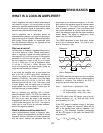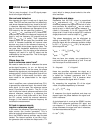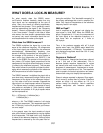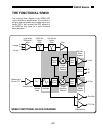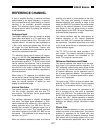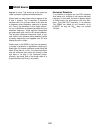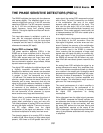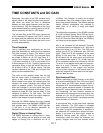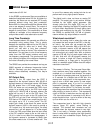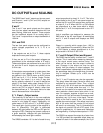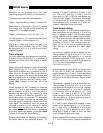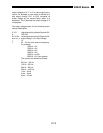
3-9
SR850 Basics
The SR850 multiplies the signal with the reference
sine waves digitally. The amplified signal is con-
verted to digital form using a 16 bit A/D converter
sampling at 256 kHz. The A/D converter is preced-
ed by a 102 kHz anti-aliasing filter to prevent
higher frequency inputs from aliasing below
102 kHz. The signal amplifier and filters will be dis-
cussed later.
This input data stream is multiplied, a point at a
time, with the computed reference sine waves
described previously. Every 4 µs, the input signal
is sampled and the result is multiplied by the two
reference sine waves (90° apart).
Digital PSD vs Analog PSD
The phase sensitive detectors (PSD's) in the
SR850 act as linear multipliers, that is, they multi-
ply the signal with a reference sine wave. Analog
PSD's (both square wave and linear) have many
problems associated with them. The main prob-
lems are harmonic rejection, output offsets, limited
dynamic reserve and gain error.
The digital PSD multiplies the digitized signal with
a digitally computed reference sine wave.
Because the reference sine waves are computed
to 20 bits of accuracy, they have very low harmon-
ic content. In fact, the harmonics are at the
-120 dB level! This means that the signal is multi-
plied by a single reference sine wave (instead of a
reference and its many harmonics) and only the
signal at this single reference frequency is detect-
ed. The SR850 is completely insensitive to signals
at harmonics of the reference. In contrast, a
square wave multiplying lock-in will detect at all of
the odd harmonics of the reference (a square
wave contains many large odd harmonics).
Output offset is a problem because the signal of
interest is a DC output from the PSD and an
output offset contributes to error and zero drift.
The offset problems of analog PSD's are eliminat-
ed using the digital multiplier. There are no errone-
ous DC output offsets from the digital
multiplication of the signal and reference. In fact,
the actual multiplication is totally free from errors.
The dynamic reserve of an analog PSD is limited
to about 60 dB. When there is a large noise signal
present, 1000 times or 60 dB greater than the full
scale signal, the analog PSD measures the signal
with an error. The error is caused by non-linearity
in the multiplication (the error at the output
depends upon the amplitude of the input). This
error can be quite large (10% of full scale) and
depends upon the noise amplitude, frequency, and
waveform. Since noise generally varies quite a bit
in these parameters, the PSD error causes quite a
bit of output uncertainty.
In the digital lock-in, the dynamic reserve is limited
by the quality of the A/D conversion. Once the
input signal is digitized, no further errors are intro-
duced. Certainly the accuracy of the multiplication
does not depend on the size of the numbers. The
A/D converter used in the SR850 is extremely
linear, meaning that the presence of large noise
signals does not impair its ability to correctly digi-
tize a small signal. In fact, the dynamic reserve of
the SR850 can exceed 100 dB without any prob-
lems. We'll talk more about dynamic reserve a little
later.
An analog linear PSD multiplies the signal by an
analog reference sine wave. Any amplitude varia-
tion in the reference amplitude shows up directly
as a variation in the overall gain. Analog sine wave
generators are susceptible to amplitude drift, espe-
cially as a function of temperature. The digital ref-
erence sine wave has a precise amplitude and
never changes. This eliminates a major source of
gain error in a linear analog lock-in.
The overall performance of a lock-in amplifier is
largely determined by the performance of its
phase sensitive detectors. In virtually all respects,
the digital PSD outperforms its analog
counterparts.
We've discussed how the digital signal processor
in the SR850 computes the internal oscillator and
two reference sine waves and handles both phase
sensitive detectors. In the next section, we'll see
the same DSP perform the low pass filtering and
DC amplification required at the output of the
PSD's. Here again, the digital technique eliminates
many of the problems associated with analog lock-
in amplifiers.
THE PHASE SENSITIVE DETECTORS (PSD's)



